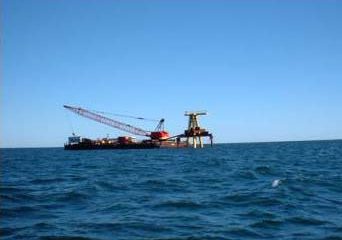Earth Sciences (also referred to as Geosciences), which deals with basic issues surrounding our planet, plays a vital role in the area of energy and raw materials supply.
Earth Sciences comprises subjects such as geology, geography, geological informatics, paleontology, mineralogy, petrography, crystallography, geophysics, geodesy, glaciology, cartography, photogrammetry, meteorology and seismology, early-warning systems, earthquake research and polar research.

Balloon Experiments Reveal New Information About Sprites
An atmospheric phenomenon called “sprites” could be pumping 50 times more energy into the upper atmosphere than was previously thought, suggesting our understanding of the global atmosphere is incomplete, according to University of Houston space physicists.
Sprites are large, brief flashes of light that occur very high in the atmosphere above large thunderstorms. Instead of discharging toward the earth like lightning,

Air-sea interaction tower built off Martha’s vineyard
In the deep waters two miles south of Edgartown on Martha’s Vineyard, not far from where, two centuries ago, the likes of Captain Ahab and a thousand others kept their watch for the great white and his kin, we are now searching to understand another potential beast in those parts: the ocean and the weather.
But this is no allegory. Hoping to avoid any recurrence in these sometimes turbulent waters of the horrendo

Nothing seems more down-to-Earth than dirt, but scientists are going to space to understand how earthquakes and related strains and stresses disturb soil and sand.
When Space Shuttle Columbia lifts off in January, it will carry the Mechanics of Granular Materials (MGM) experiment, which studies soil behavior under conditions that cannot be duplicated on Earth — the microgravity, or low-gravity created as the Shuttle orbits Earth.
Results from this granular mechanics research can le

By examining volcanic rocks retrieved from deep in the ocean, scientists have found they can estimate the carbon dioxide stored beneath much of the earth’s surface – a development that could enhance understanding of how volcanoes affect climate. The research by University of Florida scientists and others will be reported this week in the journal Nature.
Scientists examined chunks of basalt, a type of volcanic rock formed when lava cools, from 12,000 feet below the Pacific along a massiv

As anyone with a smattering of geological knowledge knows, Earth’s crust is made up of plates that creep over the planet’s surface at a rate of several inches per year. But why do they move the way they do? Even experts have had trouble teasing out the exact mechanisms.
A model developed by University of Michigan researchers and published in the Oct. 4 issue of Science provides a relatively simple explanation.
“It’s been known that slabs (portions of plates that ext

Scientists from NASA and the Commerce Department’s National Oceanic and Atmospheric Administration (NOAA) have confirmed the ozone hole over the Antarctic this September is not only much smaller than it was in 2000 and 2001, but has split into two separate “holes.”
The researchers stressed the smaller hole is due to this year’s peculiar stratospheric weather patterns and that a single year’s unusual pattern does not make a long-term trend. Moreover, they said, the data are not conclusive t